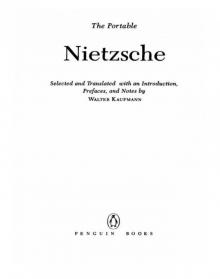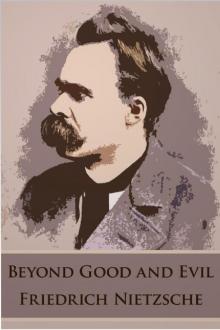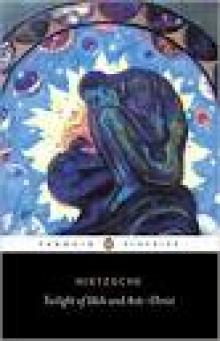- Home
- Friedrich Nietzsche
Thus Spoke Zarathustra Page 2
Thus Spoke Zarathustra Read online
Page 2
1872 Nietzsche spends many weekends and holidays with Wagner and his wife and the artists and intellectuals of their circle. Die Geburt der Tragödie (The Birth of Tragedy), Nietzsche’s first book, is published; an original work, it stirs controversy among academics.
1873 Nietzsche publishes an attack on a popular theologian and culture critic with “David Strauss der Bekenner und der Schriftsteller” (“David Strauss, the Confessor and the Writer”), the first of the four parts of Unzeitgemässe Betrachtungen (Untimely Meditations), a critique of European culture. Suffering from eye pain and headaches, he dictates his manuscripts at times.
1874 Two more meditations are published: “Vom Nutzen und Nachteil der Historie für das Leben” (“On the Uses and Disadvantages of History for Life”) and “Schopenhauer als Erzieher” (“Schopenhauer as Educator”).
1875 Frequently ill, Nietzsche travels to Germany to “take a cure.” Though a doctor helps alleviate his stomach discomfort, he continues to suffer from stomach pain and headaches, and his health deteriorates.
1876 The final meditation, “Richard Wagner in Bayreuth,” is published. Because of ill health, Nietzsche takes a year’s leave from the university. A schism in his friendship with Wagner opens over intellectual and artistic disagreements.
1878 Menschliches Allzumenschliches (Human, All Too Human), a book of philosophical aphorisms, is published; it is criticized by many, including the anti-Semitic Wagner, who sees it as too favorable to the Jews.
1879 Worsening health forces Nietzsche to resign his professorship at Basel. “Vermischte Meinungen und Sprüche” (“Mixed
Opinions and Maxims”)—an appendix to Human, All Too Human—is published.
1880 Plagued by health problems, Nietzsche begins a lonely, peripatetic life, traveling almost every year during the coming decade between various French, Swiss, Italian, and German cities, always focusing on his writing. The second and final sequel to Human, All Too Human—“Der Wanderer und sein Schatten” (“The Wanderer and His Shadow”) is published.
1881 Die Morgenröte: Gedanken über die moralischen Vorurteile (Daybreak: Thoughts on the Prejudices ofMorality) is published; it contains themes that Nietzsche will develop more fully in later writings. Russian tsar Alexander II is assassinated.
1882 Die fröhliche Wissenschaft (The Gay Science) is published; in it Nietzsche introduces his concepts of “eternal recurrence” and the death of God. In Rome Nietzsche meets and falls in love with Lou Andreas-Salomé, a young student who is also admired by Nietzsche’s close friend Paul Rée. Nietzsche’s attempts to woo Andreas-Salomé fail.
1883 Nietzsche publishes the first part of his masterpiece Thus Spoke Zarathustra. Richard Wagner dies. Elisabeth, whose relationship with her brother is often strained, announces her engagement to Bernhard Förster, a noted anti-Semite.
1884 The second part of Zarathustra is published; as in the case of the first part, few copies are sold. Soon after, the third part, also a poor seller, appears in print.
1885 Nietzsche privately prints the fourth part of Zarathustra. Elisabeth Nietzsche marries Förster, inciting the anger of her brother, who unequivocally opposes her husband’s anti-Semitism.
1886 Nietzsche publishes Jenseits von Gut und Böse (Beyond Good and Evil). Elisabeth travels to Paraguay to help her husband found an Aryan society. Nietzsche begins to revisit and rework some of his earlier writings. The first three parts of Zarathustra are published together for the first time.
1887 Zur Genealogie der Moral (On the Genealogy of Morals) is published.
1888 In a year of intense productivity, Nietzsche writes a polemic against Christianity, Der Antichrist (1895; The Antichrist); Die Götzen-Dämmerung (1889; Twilight of the Idols), a critique of
esteemed philosophers and cultural figures; Ecce Homo (1908), in which he examines his own work; and Nietzsche contra Wagner (1895). He writes and publishes an attack on Wagner, Der Fall Wagner (The Case of Wagner).
1889 In January Nietzsche collapses in the streets of Turin, Italy, suffering a complete breakdown of his mental abilities from which he will never recover. Franz Overbeck, Nietzsche’s close friend, takes him to a psychiatric clinic in Basel, but soon afterward he is transferred to an asylum in Jena, Germany. Bernhard Förster, deep in debt, commits suicide.
1890 Nietzsche is released from the clinic into the care of his mother in Naumburg. William James publishes The Principles of Psychology.
1891 The first English edition of Thus Spoke Zarathustra, translated by Thomas Common, is published.
1893 Elisabeth returns from Paraguay for the last time and establishes the Nietzsche Archive, a library of Nietzsche’s letters, manuscripts, and published writings.
1894 In a French case fueled by anti-Semitism, Capt. Alfred Dreyfus is convicted of giving military secrets to the Germans.
1895 Pressured by Elisabeth, Nietzsche’s mother signs away all rights to his works, allowing Elisabeth to assume complete control over her brother’s writings.
1896 Richard Strauss’s tone poem Thus Spoke Zarathustra premieres.
1897 Nietzsche’s mother dies, and Elisabeth moves her brother to Weimar, where she will take care of him until his death.
1900 Friedrich Nietzsche dies on August 25. Some say his condition is symptomatic of syphilis; however, recent research points to a brain tumor as the cause of his physical and mental disease. Sigmund Freud publishes Die Traumdeutung (The Interpretation of Dreams).
1901 Cobbling together notes by Nietzsche, including many he had used in his works, but with important changes, Elisabeth publishes Der Wille zur Macht (The Will to Power), which she claims represents her brother’s true philosophy.
1903 George Bernard Shaw publishes his play Man and Superman.
1914 World War I begins following the assassination of Archduke Franz Ferdinand, heir to the throne of the Austro-Hungarian Empire, by a Slav nationalist.
1918 World War I ends with the defeat of the Central Powers (Austria-Hungary, Germany, and Italy).
1930 Elisabeth becomes associated with the Nazis; through her influence so, too, does the work of Nietzsche.
1933 The Nietzsche Archive receives financial support from Hitler’s government.
1935 Elisabeth Nietzsche dies; her funeral is attended by Adolf Hitler.
1939 World War II begins as Germany invades Poland.
1945 The Nazis’s unconditional surrender on May 7 brings an end to World War II in Europe.
1950 Walter Kaufmann, who will become one of the primary modern translators of Nietzsche’s work, publishes Nietzsche: Philosopher, Psychologist, Antichrist. The book exposes Elisabeth’s manipulations of her brother’s writings and ushers in a new era of Nietzsche scholarship that distances the philosopher’s work from the taint of Nazism.
INTRODUCTION
In 1880, as the science and industry of Western Europe were redefining the modern world and a newly unified Germany flexed its muscles, a lone philosopher, hiking by a breathtaking lake in the Alps, began resurrecting an ancient Persian prophet to send him into the contemporary world. Friedrich Nietzsche published the first part of his Also sprach Zarathustra (Thus Spoke Zarathustra) in 1883, and the completed volume became his best-known book. He considered it his most important work, and toward the end of his life he immodestly described it in Ecce Homo (1908) as “the greatest present” that had been made to humanity so far. In the same book, he no less outrageously proclaims that it is “not only the highest book there is ... but it is also the deepest, born out of the innermost wealth of truth.” So we should not be surprised to find that Zarathustra is an extremely enigmatic and often pretentious work and by no means easy to understand or to classify. It is not clearly philosophy, or poetry, or prophecy, or satire. Sometimes it seems to be all of the above. It is also difficult because it is filled with learned allegories and allusions—to the Bible, Plato, Shakespeare, Goethe’s Faust, Ludwig Feuerbach, Arthur Schopenhauer, Nietzsche’s former friend Richard Wagner, and others-referenc
es that might not be readily recognizable by most contemporary readers. Zarathustra’s subtitle, “A Book for All and None,” also sounds like a challenge, if not a direct affront, suggesting that while anyone might pick it up and read it, no one can really understand it. In the then anxious world of modern Europe, already preparing for the calamities and traumas of the twentieth century, Zarathustra would find itself curiously at home.
The basic format of Zarathustra is familiar. It tells a story in biblical style. Zarathustra is an epic that resembles no other book so much as the New Testament, a work that Nietzsche, who had originally intended to enter the ministry (and whose father and grandfathers had all been ministers), knew very well. Like Jesus in the New Testament, the titular character of Nietzsche’s book goes into solitude at the age of thirty and returns to humanity with a mission—to share his wisdom with others, to challenge them to reform their lives. But like Jesus, Zarathustra is seriously misunderstood. The book thus chronicles the protagonist’s efforts and wanderings, his coming to understand who he is and what he stands for, by way of his interactions with the various and often odd characters he meets along the way.
Nevertheless, there are obvious and dramatic differences between Zarathustra and the Gospels. To begin with, unlike Jesus, who returns from solitude after forty days, Zarathustra enjoys solitude for ten years before beginning his mission. And while the story of Jesus is completed with his death and resurrection, Zarathustra’s story is never finished. Indeed, the book starts exactly as it begins, with Zarathustra’s leaving his mountain cave and descending once again to humanity. While Jesus is presented as enlightened throughout his teaching mission, Zarathustra matures only gradually. His whole story can be understood as an instance of the popular German genre of Bildungsroman—that is, a novel chronicling the education of its protagonist. Most important, the “gospel” that Zarathustra brings contrasts sharply with the teachings of Jesus. In Nietzsche’s version, Zarathustra utterly rejects the distinction between good and evil, and with it the basic premise of Judeo-Christian morality. He also denounces the “otherworldly” outlook of Christianity, its emphasis on a “better” life beyond this one. Zarathustra’s philosophy, summarized in a single phrase, is a celebration of what is “this-worldly.” It is a “yes-saying” to life, this life; for Zarathustra (like Nietzsche) thinks that there is no other. The combined allusions to and discrepancies from the New Testament in Zarathustra make it appropriate to think of it as a parody, although it should not be thought of just as satire, which ridicules its target. On the blasphemous side, however, Zarathustra is treated as a figure whose seriousness and importance are comparable to those of Jesus.
Many readers may not know that Nietzsche’s titular character is a very important historical religious figure. Zarathustra, also known as Zoroaster, probably lived in the seventh century B.C.E. (possibly from 628 to 551). He was a Persian who founded his own religion. Zoroastrianism, in turn, had a profound influence on both Judaism and Christianity. Zarathustra remained a fantasy figure in the West for many centuries, long before his writings were translated in the eighteenth century. Central to the teachings of the historical Zarathustra was the idea that the world is a stage on which cosmic moral forces, the power of good and the powers of evil, fight it out for dominance over humanity. This conflict between good and evil is central to both Judaism and Christianity, and given Nietzsche’s rejection of this dichotomy, it is highly significant as well as ironic that Nietzsche chose the supposed originator of that distinction as his central character and ostensibly as his spokesman. Nietzsche tells us in Ecce Homo that as the first to invent the opposition of good and evil, Zarathustra should be the first to recognize that it is a “calamitous error,” for he has more experience and is more truthful than any other thinker. Nietzsche’s Zarathustra is the historical religious leader updated, offering insight into the modern world, just as the original Zarathustra addressed the circumstances of his era.
One could argue that Nietzsche used his fictional Zarathustra much as Plato used his teacher, Socrates (who never wrote down his teachings), to express his own views. And given that Nietzsche had a doctorate in classical philology and taught the classics for many years, we should not be surprised to find that Nietzsche’s book makes extensive references to Plato’s dialogues and their hero. Socrates, along with Jesus, remained one of the focal points of Nietzsche’s philosophy from his first book to his last. Socrates is a figure of profound importance to the Western tradition. In Nietzsche’s first book, Die Geburt der Tragödie (1872; The Birth of Tragedy), he called Socrates “the one vortex and turning-point” of Western culture. In one of his last books, Die Götzen-Dämmerung (1889; Twilight of the Idols), he devotes an entire chapter to “The Problem of Socrates,” which is nothing less than the problem of Western civilization as such. In his life, Socrates was a self-styled gadfly to his contemporaries, provoking them to question their basic beliefs, which for the most part they held just because others held them too. His unrelenting challenge to common morals and public authority ultimately led to his being convicted on trumped-up charges and executed. Nietzsche’s Zarathustra is similarly devoted to challenging both “common sense” and the authority of tradition, and he similarly arouses hatred in those committed to them.
Yet again there are sharp differences between Socrates and Zarathustra. Socrates was devoted to what Nietzsche came to see an “absurd rationality” that undervalued the emotions and other irrational aspects of our nature. Moreover, Plato’s Socrates contends that the philosophical life is a long practice in learning how to die, and he offers an ethereal vision of truth in a separate, heavenly plane. According to Plato’s hero, the body drags the soul down and distracts it from this true reality, which can be grasped only by reason. Consequently, Nietzsche sees Platonism as otherworldly and life-denying, a prefiguring of the Judeo-Christian worldview in its negativism; in Jenseits von Gut und Böse (1886; Beyond Good and Evil) he calls Christianity “Platonism for the masses.” Nietzsche’s Zarathustra is a parodic counterpart to Plato’s Socrates, for Zarathustra urges appreciation of this world, the body, and our passions, directly contradicting Plato’s account of the purely rational, otherworldly philosophical life.
Thus the opening of Zarathustra recalls the Myth of the Cave from Plato’s Republic 7. In that work, Socrates describes a cave in which people bound to a wall see shadows cast onto the cave’s wall; the shadows are the entirety of their experience. One individual, who represents the philosopher, manages to get loose and emerge from the cave, where he discovers the whole world that the sun illuminates. He returns to his companions in the cave to tell them what he has found. But his companions want none of his reports. They are convinced that he has ruined his eyesight, since it took him some time to readjust to the darkness, and they want to kill him. Zarathustra similarly emerges from the cave, but the wisdom he has to share comes from his experiences inside it. The sun, which represents the all-illuminating form of the Good for Plato, is also the image of Apollo, the god of reason and order. Nietzsche describes Greek tragedy in The Birth of Tragedy as combining the wisdom of Apollo with that of Dionysus, the god of drunkenness, passion, and the irrational powers of the psyche. Nietzsche insists that Apollo alone or Dionysus alone represents only part of the human experience, and that the psychological reality of the human being as a whole requires a combination of what these gods represent. Zarathustra appreciates both the insights of his cave and the illumination of the sun, in that his wisdom appreciates both parts of our nature, while Plato addresses only one.
Thus Spoke Zarathustra opens with a prologue that is a minidrama unto itself. Its plot, in brief, is this: Zarathustra emerges in the morning from his mountain cave and sings a hymn to the sun, vowing like the sun to bestow his riches on humanity, which in Zarathustra’s case amounts to the wisdom he has discovered in his solitude. He descends and meets an ascetic saint in the forest, who urges him not to go to humanity. Continuing his descent, Zarathustra comes upon a
group of people who have gathered for a circus performance. It is here that Zarathustra addresses them and attempts to inspire them with a speech about the Übermensch (“superman”), but he is grotesquely misunderstood. The people think that Zarathustra is a circus barker and that the Übermensch is the tightrope walker about to perform above their heads. As the tightrope walker begins his performance, he is taunted by a jester and falls to his death. Zarathustra comforts the performer as he dies and promises to bury him. Taking the corpse with him, Zarathustra is threatened by the jester and some gravediggers. He wanders in the forest and takes refuge in the home of a hermit, who offers him and his dead companion bread and wine to eat. After burying the corpse in a hollow tree, Zarathustra, feeling misunderstood, takes stock and concludes that he should seek companions, or at least like-minded individuals, instead of addressing crowds en masse. At the end of the Prologue, an eagle and a snake join Zarathustra, who calls them “my animals” and compares them to his pride and his wisdom. (Such comparisons with animals occur throughout Zarathustra.)
The Prologue reads a bit like a dream report, yet it serves as a kind of overture to Zarathustra as a whole, raising many of the book’s main themes and suggesting the basic problems that Zarathustra will confront. The opening section of the Prologue, Zarathustra’s hymn to the sun, is virtually identical to the last section of Nietzsche’s previous book, Die fröhliche Wissenschaft (The Gay Science, 1882; also translated as The Joyous Wisdom). In that work, the section is titled “Incipit tragoedia,” Latin words meaning “the tragedy begins.” Nietzsche had suggested at the beginning of The Gay Science that tragic ages are those that seek some purpose to human existence and accept the doctrines of some moral teacher about the nature of values, good, and evil. Thus there is the hint that Zarathustra’s hymn initiates a tragedy. But according to Nietzsche, also in The Gay Science, tragic ages give way to comic ages, in which the meaning or purpose of life is no longer raised as a question, for life is assumed to be valuable just as it is. The recovery of that sense that life is valuable for its own sake is also the goal of Zarathustra.

 The Portable Nietzsche
The Portable Nietzsche Twilight of the Idols/The Anti-Christ
Twilight of the Idols/The Anti-Christ Thus Spoke Zarathustra
Thus Spoke Zarathustra Why I Am So Clever
Why I Am So Clever Beyond Good and Evil
Beyond Good and Evil Twilight of Idols and Anti-Christ
Twilight of Idols and Anti-Christ Twilight of Idols and Anti-Christ (Penguin Classics)
Twilight of Idols and Anti-Christ (Penguin Classics)